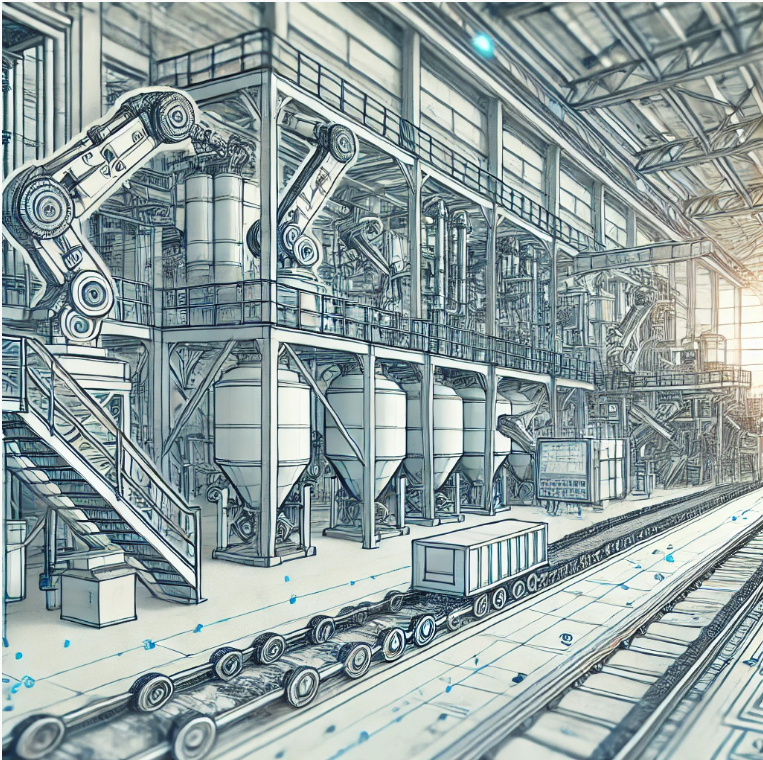Contents
Automated Material Handling Equipment in Cement Plants: A Turnkey Solution

TO Download this post and all the books and excel sheets and my personal notes and presentations I collected about cement industry in the last 30 years click the below paypal link
In modern cement plants, the demand for automation and efficiency has never been higher. Cement production is a complex process that involves the handling of raw materials like limestone, clay, and additives. With increasing production targets and a need to optimize operational costs, cement manufacturers are turning to automated material handling systems. These systems not only enhance productivity but also improve safety and reduce operational downtime.
This article explores the role of automated material handling equipment in cement plants, detailing the various systems in place and how turnkey solutions provide a comprehensive answer to the industry’s needs.
Why Automated Material Handling?
Automated material handling equipment provides several benefits in cement production. It ensures smooth operations from raw material collection to the final product, reducing manual intervention, which minimizes the risk of errors and accidents.
Some of the main advantages include:
- Increased Efficiency: Automated systems allow for faster transportation and processing of materials, which increases production rates.
- Cost Reduction: Automation reduces labor costs and minimizes the risk of downtime caused by human errors.
- Improved Safety: By eliminating the need for manual handling, automation reduces workplace accidents and improves overall safety in the plant.
Key Components of Automated Material Handling Systems
The automated material handling system in a cement plant is comprised of several crucial elements that work together to ensure seamless production. Below are the key components:
- Conveyors: Belt conveyors are used extensively in cement plants to transport materials such as raw mix, clinker, and cement to various processing units. These conveyors are highly durable and can operate under extreme conditions like high temperatures and dust exposure.
- Bucket Elevators: These are used to vertically lift raw materials and other bulk materials within the plant. Bucket elevators are essential for transferring materials between various stages of the production process, ensuring that materials reach the desired processing unit.
- Stacker and Reclaimer: Automated stacker and reclaimer systems manage the storage of raw materials. Stacker systems pile materials in the yard, while reclaimers automatically retrieve them when needed, ensuring smooth and uninterrupted material flow into the kiln feed system.
- Pneumatic Conveyors: For finer materials such as powdery cement, pneumatic conveyors are used to transport materials through air-filled pipelines. This method is efficient for materials that are difficult to handle using mechanical systems.
- Robotic Systems: Robots are increasingly being employed in cement plants for tasks like bagging and palletizing. Automated robots improve accuracy and reduce manual handling of finished cement bags, reducing product damage.
Turnkey Solutions: A Comprehensive Approach
Turnkey solutions for material handling in cement plants provide end-to-end solutions from design and implementation to maintenance and upgrades. These solutions are highly sought after as they simplify the process for plant operators by integrating all equipment and systems under a single platform.
Key aspects of turnkey solutions include:
- Design and Engineering: A tailored system is designed to meet the specific needs of the plant, considering factors like capacity, material types, and production targets.
- Integration: All equipment and systems, from conveyors to robotic systems, are seamlessly integrated to ensure smooth and efficient operations.
- Maintenance and Support: After implementation, service providers offer ongoing maintenance and support to ensure the system runs optimally, reducing downtime and operational costs.
Industry Examples
Several cement manufacturers have successfully implemented automated material handling systems, yielding impressive results. For example, large-scale cement plants in Asia have adopted turnkey solutions that integrate pneumatic conveyors, robotic bagging systems, and automated stacker-reclaimer units. These plants have reported up to a 30% increase in production efficiency, coupled with a significant reduction in labor costs.
The Future of Material Handling in Cement Plants
As the industry continues to advance, we can expect further innovations in automation technologies. Artificial intelligence (AI) and machine learning are already making their way into material handling systems, offering predictive maintenance and real-time operational insights. In the near future, fully autonomous cement plants, driven by AI and IoT technologies, could become the norm, further boosting production efficiency and reducing operational complexities.
Conclusion
Automated material handling systems represent a critical component of modern cement plants. Turnkey solutions provide a holistic approach to optimizing material transport and storage processes, resulting in improved efficiency, reduced costs, and enhanced safety. As the cement industry continues to evolve, embracing these automated systems will be key to remaining competitive in an increasingly demanding market.
TO Download this post and all the books and excel sheets and my personal notes and presentations I collected about cement industry in the last 30 years click the below paypal link
